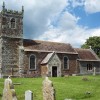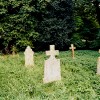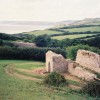Wool lies on the banks of the River Frome at the eastern end of the area Hardy called Egdon Heath, the dark background for some of his novels. The parish developed considerably during the early 20th century to serve as a gateway for the throngs of sightseers heading for the ruins of Bindon Abbey and a view of Woolbridge Manor, which was the inspiration for Hardy’s Wellbridge House where Tess and Angel Clare spent their ill-fated honeymoon. The arrival of the Nuclear Research Station at nearby Winfrith Newburgh required additional housing supply in the area but long before that Treves in his Highways and Byways described Wool as “once pretty enough.”The Dorset coast around Lulworth Cove can be accessed from Wool.
At an enquiry in 1343 it was settled that “the Woolbridge is and always has been maintained and repaired by alms and nobody is bound to maintain or repair it.” There are records of repairs being carried out on a bridge here in 1607 and 1688. The present bridge is probably from the 16th century. It was built in five arches, its massive piers with cutwaters providing recesses for foot-passengers using its narrow 12ft road should a wagon or van come along. A new bridge for motor traffic was opened in 1953 and now the old bridge is limited to carrying only pedestrians and cyclists.
There is a local legend that says a phantom coach crosses the bridge by Woolbridge Manor at night, but only those with Turberville blood can see it. The legend appears in several versions including one that links it to the elopement of John Turberville and Anne, the daughter of Thomas Howard, 1st Viscount Howard of Bindon. Hutchins says there were over the door in the hall the arms of Turberville impaling Howard of Bindon. John Turberville who died in 1623 married Lady Anne Howard. Hardy makes mention of the legend in Tess of the D’Urbervilles.
Woolbridge Manor is just outside of Wool on the northern bank of the river. It earned praise from Pevsner who says of it: “the survival in a mellow unspoilt condition, in spite of being a hotel is a triumph.” It formerly belonged to the Turbeville family and can be approached by using the historic crossing point over the Frome, the old Wool Bridge.
Thomas Turberville acquired the manor of Woolbridge early in the reign of Queen Elizabeth I. Before the Dissolution of the Monasteries the manor had been a possession of Bindon Abbey. What we see today is probably only a part of the original Elizabethan house. The front of the house faces north and on its porch is a stone with the letters I.T. and a date, which is unclear but could be 1635 or 1655. If it is the later date it might refer to rebuilding possibly as a consequence of damage caused during the Civil War; the house is said to have been garrisoned during the Civil Wars while it was owned by Sir John Turberville, who was Sheriff of the County in 1652.
The Manor House has three storeys of red brick and stone, the roofs have clay tiles with stone slates to the eaves. Many windows around the building have been removed at some time, possibly due to the window tax in 1696. The front is a good example of 17th century brickwork but the stone gables at either end are certainly older but the fine brick chimneys date from the 17th century.
Stories persist that a tunnel runs from the house under the river to Bindon Abbey.



